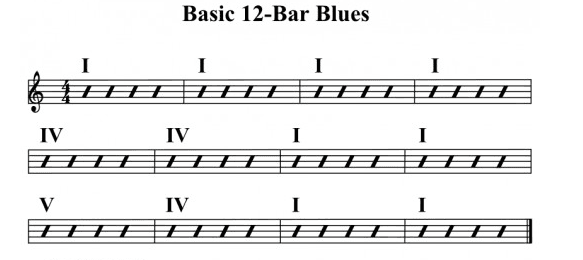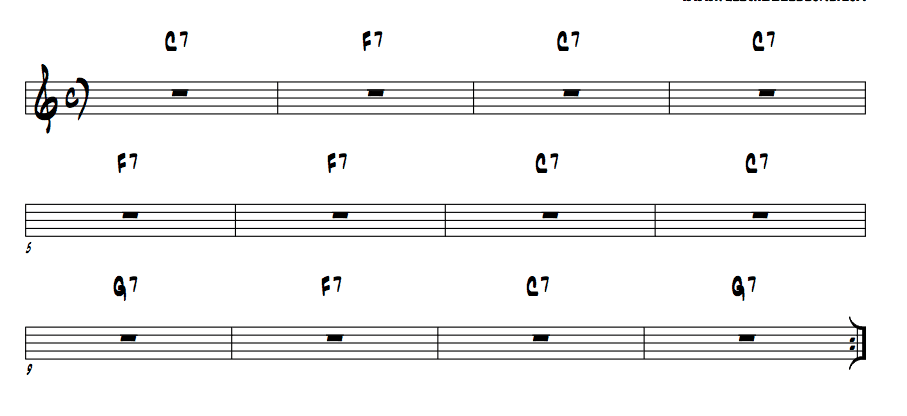Blues Chord Progression: 4 Tricks You Should Swipe
 Want to learn how to really spice up a blues chord progression? You’ve come to the right place.
Want to learn how to really spice up a blues chord progression? You’ve come to the right place.
In today’s free video lesson I’m going to teach 4 super sweet things you can do to decorate the first 4 bars of the blues.
This will help you play chorus after chorus of the blues and keep your listener entertained. Plus, these blues chord progression moves sound super cool!
Blues Chord Progression Tutorial Video
Take a minute and watch this video. Hearing and seeing is everything! Then, scroll down and read the additional tips.
Important Blues Chord Progression Starter Points
 The first four bars of the blues are actually really malleable.
The first four bars of the blues are actually really malleable.
Essentially, that’s a fancy way of saying you can change the chords on them. The way that we change the chords on them will get you totally different sounding stylistic elements.
For example, we could play it one way and it will sound really kind of like down home, early blues.
We can play it another way, it will sound a little bit more like a Chicago blues or a Chicago shuffle.
 The third way we can play it, it could sound a lot more like Oscar Peterson or Wynton Kelly. Then the fourth way we play it, we could sound more like Charlie Parker or Barry Harris.
The third way we can play it, it could sound a lot more like Oscar Peterson or Wynton Kelly. Then the fourth way we play it, we could sound more like Charlie Parker or Barry Harris.
Read below to see what you can do…
How Smart Musicians Will Practice This
We are in the key of C for these examples here, but as a reminder, always apply what you learn in one key to other keys.
This is what frees you up at the keyboard here. As we go along, we’re going to get more an more harmonically sophisticated, but the first place we’re going to start here is just really kind of a “Gut Bucket” blues.
Blues Chord Progression Variation #1
What you’re going to do for the first four bars of the blues chord progression is we’re going to hang on the one chord.
Just hang on C7 the whole time. Simple stuff.

All you’re doing there is just hanging on the one chord. As long as you’ve got a good groove, there’s nothing wrong with just laying in the pocket and staying on that one chord.
That’s just concept number one. Just because we’re playing jazz doesn’t mean we can’t just groove and hang out on one chord.
Blues Chord Progression Variation #2
The next concept, similar to what we had in the first concept, but we’re going to do one small little variation. This variation is called “The Quick 4”.
Instead of doing this four bars of one, et cetera, et cetera, we’re going to do 1 bar of the I chord, 1 bar of the IV chord, then 2 bars again of the I chord.
The quick IV chord sort of resets the chord changes and a little bit different sounding. A little bit more sophisticated, we’re edging further forward here. That’s variation number two, “The Quick 4”.

Blues Chord Progression Variation #3
All right, variation number three. This is considered a little bit more of a jazz blues chord progression now.
What you’re going to be doing here is you’re going to build off of what we saw in variation two, where we’re going to have that one chord in the beginning and then that four chord in bar 2, right?
We’re going to back to the I chord for bar 3, but instead of hanging out on the I chord for bar 4 we’re going to play a 2-5 chord progression in that bar instead.
This will set us up perfect to lead to the IV chord in bar 5.
As you heard in the video I was playing C7, F7, C7, and then playing the quick 2 5 chord progression in bar 4. And again since this is more of a jazz blues so I’m hipping up the chord changes and playing more jazzy voicings.
Again, getting more and more sophisticated as we go along.
 By the way, if you love all the sophisticated chords I show in this video I have a course that shows you how to play all of them and hundreds more.
By the way, if you love all the sophisticated chords I show in this video I have a course that shows you how to play all of them and hundreds more.
Plus, I also teach you how to use them inside real music that audiences love.
You can throw them into your playing today inside this program —> Premium Jazz Elite Membership Course.
Blues Chord Progression Variation #4
Our last variation for today’s free sample video is what we essentially call Parker blues changes.
What we’re going to do is we’re going to have that C7 in the very beginning, but now we’re going to do a quick two five into the vi chord.
Then, we’re going to do another two five into the 4 chord. Essentially we’re creating a huge chain of 2-5-1 chord progressions.
Simple kind of stuff here. We’re just two fiving into things, so we’ve got the C7, two five into the six chord, chromatically going down into a two five into the four chord. It continues on like that.
A lot more Bebop oriented with those particular chord changes.
I love jamming on those chords there, but I also love jamming on the first one, where we’re just hanging out on the one chord.
There are so many different ways of coloring in, bringing out your own musical taste throughout the blues.
As you saw, there’s just so many different ideas you can apply to just those first four bars of the blues.
More Bebop ideas, more Chicago based ideas, more Gut Bucket, down home one chord groove ideas. There’s so many cool things that you can do with the blues. We really just kind of scratched the surface here. It’s such a beautiful art form.
 If you want to learn more of these re-harmonization techniques and all the different things you can do with the blues, I highly recommend that you pick up the Breakthrough Blues Piano Method.
If you want to learn more of these re-harmonization techniques and all the different things you can do with the blues, I highly recommend that you pick up the Breakthrough Blues Piano Method.
Hall of fame pianist Bruce Katz and I sat down and put years of the blues discoveries we made into a powerful course.
Bruce sits down and just teaches years and years of all the amazing stuff he’s learned as far as blues piano goes. Highly recommended course. You can get access to the Breakthrough Blues Method right here.
So, enjoy your practicing on these four little blues chord progression variations. Do you have questions on today’s lesson? Have questions blues? Anything else you want to talk about? Speak your mind and would love to hear from you.
Please leave a comment below. Happy to help!
